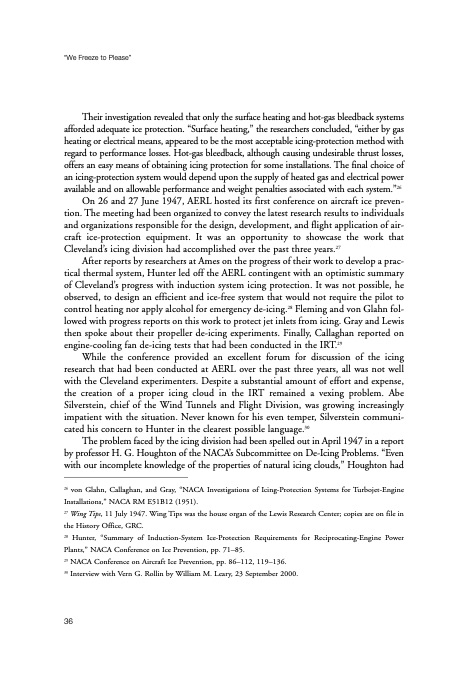
PDF Publication Title:
Text from PDF Page: 049
“We Freeze to Please” Their investigation revealed that only the surface heating and hot-gas bleedback systems afforded adequate ice protection. “Surface heating,” the researchers concluded, “either by gas heating or electrical means, appeared to be the most acceptable icing-protection method with regard to performance losses. Hot-gas bleedback, although causing undesirable thrust losses, offers an easy means of obtaining icing protection for some installations. The final choice of an icing-protection system would depend upon the supply of heated gas and electrical power available and on allowable performance and weight penalties associated with each system.”26 On 26 and 27 June 1947, AERL hosted its first conference on aircraft ice preven- tion. The meeting had been organized to convey the latest research results to individuals and organizations responsible for the design, development, and flight application of air- craft ice-protection equipment. It was an opportunity to showcase the work that Cleveland’s icing division had accomplished over the past three years.27 After reports by researchers at Ames on the progress of their work to develop a prac- tical thermal system, Hunter led off the AERL contingent with an optimistic summary of Cleveland’s progress with induction system icing protection. It was not possible, he observed, to design an efficient and ice-free system that would not require the pilot to control heating nor apply alcohol for emergency de-icing.28 Fleming and von Glahn fol- lowed with progress reports on this work to protect jet inlets from icing. Gray and Lewis then spoke about their propeller de-icing experiments. Finally, Callaghan reported on engine-cooling fan de-icing tests that had been conducted in the IRT.29 While the conference provided an excellent forum for discussion of the icing research that had been conducted at AERL over the past three years, all was not well with the Cleveland experimenters. Despite a substantial amount of effort and expense, the creation of a proper icing cloud in the IRT remained a vexing problem. Abe Silverstein, chief of the Wind Tunnels and Flight Division, was growing increasingly impatient with the situation. Never known for his even temper, Silverstein communi- cated his concern to Hunter in the clearest possible language.30 The problem faced by the icing division had been spelled out in April 1947 in a report by professor H. G. Houghton of the NACA’s Subcommittee on De-Icing Problems. “Even with our incomplete knowledge of the properties of natural icing clouds,” Houghton had 26 von Glahn, Callaghan, and Gray, “NACA Investigations of Icing-Protection Systems for Turbojet-Engine Installations,” NACA RM E51B12 (1951). 27 Wing Tips, 11 July 1947. Wing Tips was the house organ of the Lewis Research Center; copies are on file in the History Office, GRC. 28 Hunter, “Summary of Induction-System Ice-Protection Requirements for Reciprocating-Engine Power Plants,” NACA Conference on Ice Prevention, pp. 71–85. 29 NACA Conference on Aircraft Ice Prevention, pp. 86–112, 119–136. 30 Interview with Vern G. Rollin by William M. Leary, 23 September 2000. 36PDF Image | History of NASA Icing Research Tunnel

PDF Search Title:
History of NASA Icing Research TunnelOriginal File Name Searched:
sp4226.pdfDIY PDF Search: Google It | Yahoo | Bing
NFT (Non Fungible Token): Buy our tech, design, development or system NFT and become part of our tech NFT network... More Info
IT XR Project Redstone NFT Available for Sale: NFT for high tech turbine design with one part 3D printed counter-rotating energy turbine. Be part of the future with this NFT. Can be bought and sold but only one design NFT exists. Royalties go to the developer (Infinity) to keep enhancing design and applications... More Info
Infinity Turbine IT XR Project Redstone Design: NFT for sale... NFT for high tech turbine design with one part 3D printed counter-rotating energy turbine. Includes all rights to this turbine design, including license for Fluid Handling Block I and II for the turbine assembly and housing. The NFT includes the blueprints (cad/cam), revenue streams, and all future development of the IT XR Project Redstone... More Info
Infinity Turbine ROT Radial Outflow Turbine 24 Design and Worldwide Rights: NFT for sale... NFT for the ROT 24 energy turbine. Be part of the future with this NFT. This design can be bought and sold but only one design NFT exists. You may manufacture the unit, or get the revenues from its sale from Infinity Turbine. Royalties go to the developer (Infinity) to keep enhancing design and applications... More Info
Infinity Supercritical CO2 10 Liter Extractor Design and Worldwide Rights: The Infinity Supercritical 10L CO2 extractor is for botanical oil extraction, which is rich in terpenes and can produce shelf ready full spectrum oil. With over 5 years of development, this industry leader mature extractor machine has been sold since 2015 and is part of many profitable businesses. The process can also be used for electrowinning, e-waste recycling, and lithium battery recycling, gold mining electronic wastes, precious metals. CO2 can also be used in a reverse fuel cell with nafion to make a gas-to-liquids fuel, such as methanol, ethanol and butanol or ethylene. Supercritical CO2 has also been used for treating nafion to make it more effective catalyst. This NFT is for the purchase of worldwide rights which includes the design. More Info
NFT (Non Fungible Token): Buy our tech, design, development or system NFT and become part of our tech NFT network... More Info
Infinity Turbine Products: Special for this month, any plans are $10,000 for complete Cad/Cam blueprints. License is for one build. Try before you buy a production license. May pay by Bitcoin or other Crypto. Products Page... More Info
| CONTACT TEL: 608-238-6001 Email: greg@infinityturbine.com | RSS | AMP |